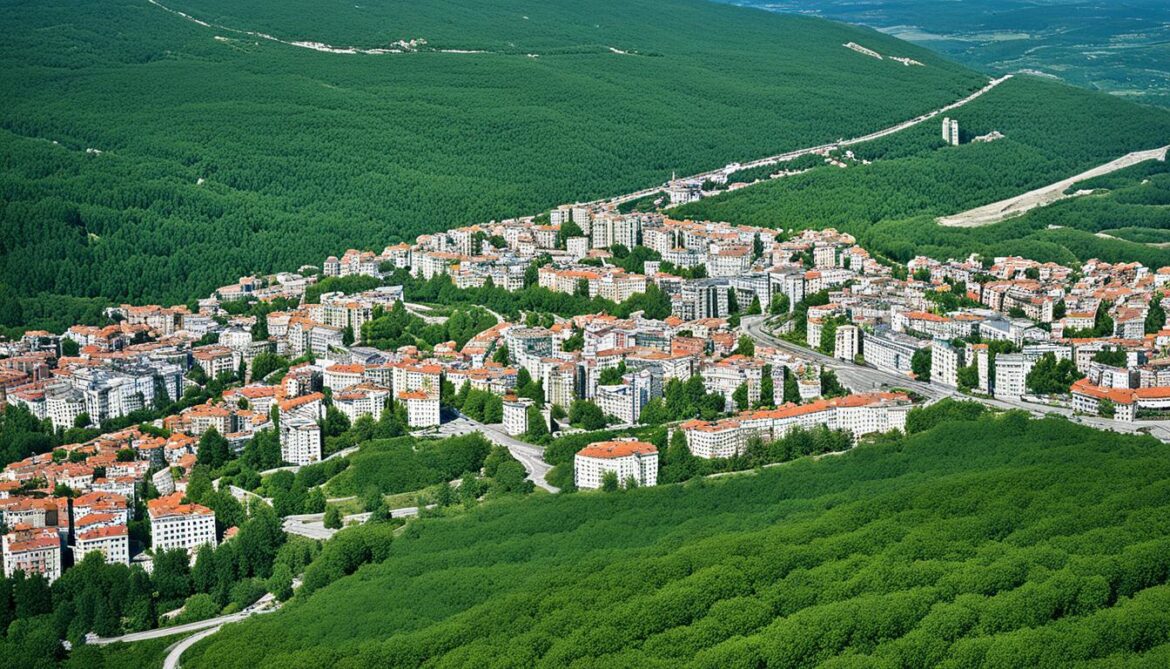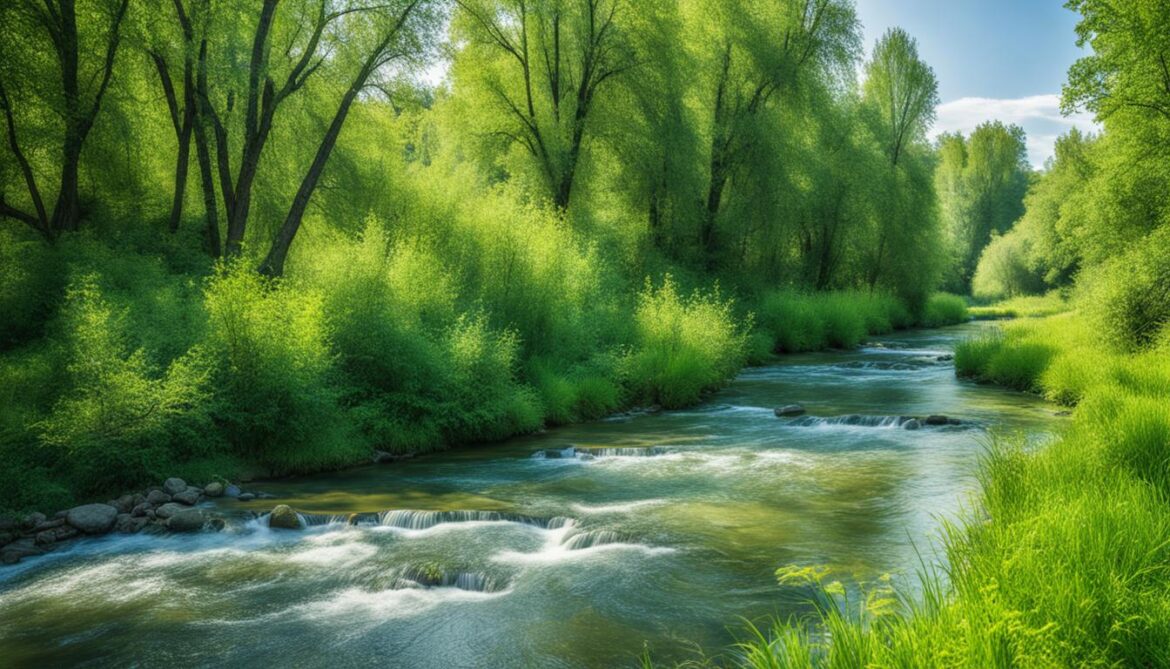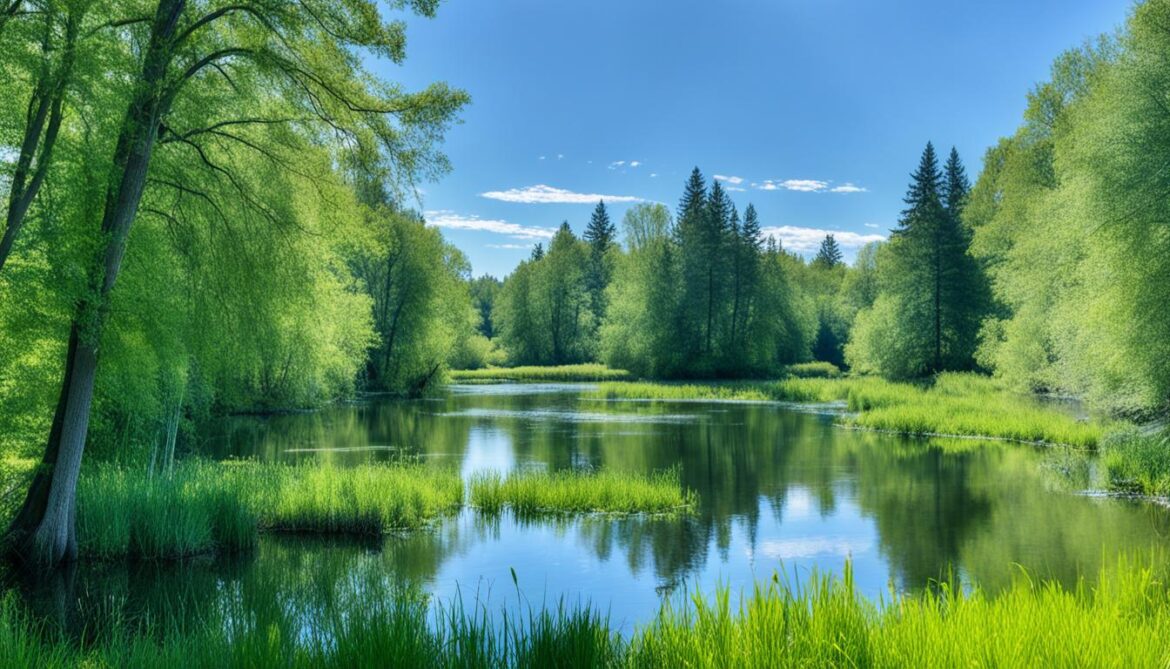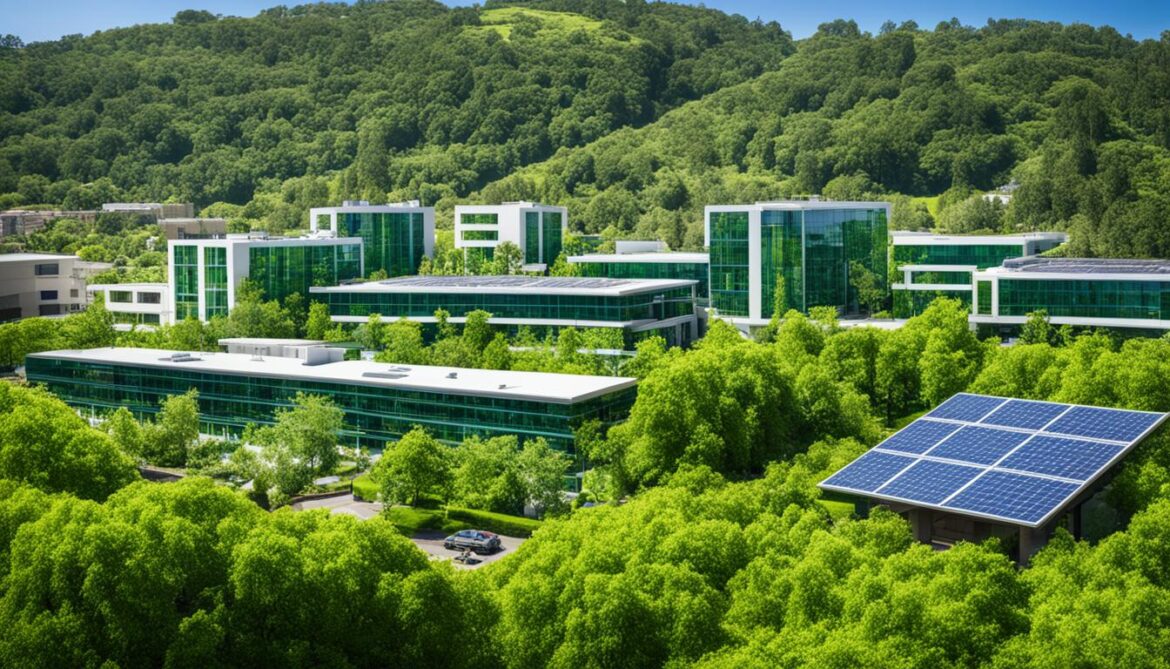Bulgaria is renowned for its diverse and abundant biodiversity, encompassing three bio-geographic regions: alpine, coastal, and continental. These regions create unique habitats that support a wide array of animal and plant species, making Bulgaria a true hotspot for biodiversity. However, preserving this natural heritage requires careful conservation practices and sustainable development in the face of urban planning and the ecological impact of human activities.
Key Takeaways:
- Bulgaria is home to rich biodiversity across its bio-geographic regions.
- The country faces the challenge of balancing conservation efforts with urban planning.
- Sustainable development is crucial for protecting Bulgaria’s natural heritage.
- Conservation practices are necessary to mitigate the ecological impact of human activities.
- Preserving wildlife and the environment is essential for the long-term well-being of Bulgaria.
The Three Bio-geographic Regions of Bulgaria
Bulgaria is home to three distinct bio-geographic regions: the alpine region, the coastal region, and the continental region. These regions play a crucial role in supporting Bulgaria’s diverse wildlife and contribute to the country’s rich biodiversity.
The alpine region, with its high-altitude meadows, crystal-clear lakes, and ancient forests, offers visitors a breathtaking experience of nature’s beauty. This pristine environment provides a habitat for a wide range of plant and animal species, including rare and endemic ones.
The coastal region of Bulgaria boasts sandy beaches, lagoons, and wetlands, creating ideal conditions for various bird species to thrive. Here, birdwatchers can witness the graceful flight of seabirds and the vibrant colors of migratory species as they make their way along the coastline.
The continental region of Bulgaria encompasses vast plains and river valleys, providing a diverse ecosystem that supports a wide range of flora and fauna. From rich fertile farmland to dense forests, this region is home to numerous wildlife species, including mammals, reptiles, and amphibians.
“The bio-geographic regions of Bulgaria offer a unique glimpse into the country’s diverse wildlife and natural beauty.”
Each bio-geographic region of Bulgaria contributes to the overall biodiversity of the country, with distinct habitats and climatic conditions supporting a variety of wildlife species. The alpine, coastal, and continental regions are vital in maintaining the delicate balance of ecosystems and preserving the unique flora and fauna that call Bulgaria home.
Unique Habitat Types in Bulgaria
Bulgaria is home to a diverse range of habitat types, with 96 unique habitats that provide crucial ecosystems for a variety of plant and animal species. These unique habitats contribute significantly to the country’s rich biodiversity and play a vital role in wildlife preservation. Let’s explore some of the exceptional habitat types found in Bulgaria:
The Strandzha Nature Park
The Strandzha Nature Park is a remarkable habitat located in the southeastern part of Bulgaria. It is home to rare and endangered species, making it a priority area for conservation efforts. This unique habitat consists of dense forests, meadows, rivers, and wetlands, creating a diverse ecosystem that supports a wide range of wildlife species.
The Rila National Park
The Rila National Park, recognized as a UNESCO World Heritage site, is one of the most iconic habitat types in Bulgaria. It spans over 810 square kilometers and supports a diverse range of ecosystems, including alpine meadows, glacial lakes, and ancient forests. The park provides a sanctuary for numerous wildlife species, including the elusive Balkan chamois and rare bird species.
The Belasitsa Nature Park
The Belasitsa Nature Park is known for its rich floral diversity and abundance of bird species. This unique habitat type is located in southwestern Bulgaria, encompassing diverse landscapes such as dense forests, grasslands, and mountain slopes. It provides a vital habitat for various wildlife species, making it a popular destination for nature enthusiasts and researchers alike.
These exceptional habitats in Bulgaria showcase the country’s commitment to wildlife preservation and environmental protection. By ensuring the conservation of these unique habitats, Bulgaria is safeguarding its rich biodiversity for future generations to admire and cherish.
Bulgaria Nature Reserves and Biodiversity Hotspots
Bulgaria is home to several nature reserves and biodiversity hotspots that play a vital role in the conservation of endangered species and the overall preservation of biodiversity. These protected areas are crucial for maintaining the delicate balance of ecosystems and ensuring the survival of diverse wildlife species.
Pirin National Park
Pirin National Park, located in southwestern Bulgaria, is a spectacular landscape known for its rugged mountain peaks and pristine alpine meadows. It is a haven for wildlife, including rare and endemic species. The park is home to the majestic Edelweiss and the agile Balkan chamois, both of which are exclusive to this region. Visitors can explore the park’s diverse habitats and witness the beauty of these extraordinary creatures in their natural environment.
Central Balkan National Park
Central Balkan National Park, situated in central and northern Bulgaria, is another biodiversity hotspot. It is characterized by dense forests, deep gorges, and picturesque mountain ranges. This park is home to the elusive Balkan lynx and the iconic brown bear. These magnificent creatures roam freely in their natural habitat, providing a glimpse into the untamed wilderness of Bulgaria.
Dzhendema Nature Reserve
In the Eastern Rhodope Mountains, you will find the Dzhendema Nature Reserve, a sanctuary for unique wildlife species. This reserve hosts the melodic Orphean warbler and the majestic Eastern imperial eagle. It serves as a vital breeding ground and refuge for these endangered birds, contributing to their conservation efforts and ensuring their long-term survival.
By establishing and maintaining these nature reserves and biodiversity hotspots, Bulgaria demonstrates its commitment to preserving its natural heritage and protecting vulnerable wildlife species. These protected areas not only provide safe havens for flora and fauna but also offer opportunities for locals and tourists to appreciate the beauty and importance of biodiversity conservation.
| Nature Reserves |
Location |
Featured Wildlife Species |
| Pirin National Park |
Southwestern Bulgaria |
Edelweiss, Balkan chamois |
| Central Balkan National Park |
Central and northern Bulgaria |
Balkan lynx, brown bear |
| Dzhendema Nature Reserve |
Eastern Rhodope Mountains |
Orphean warbler, Eastern imperial eagle |

These nature reserves and biodiversity hotspots symbolize Bulgaria’s dedication to wildlife conservation and sustainable environmental practices, ensuring the country’s natural heritage remains intact for future generations.
The Natura 2000 Network in Bulgaria
The Natura 2000 network covers approximately 34% of Bulgaria’s territory, safeguarding national parks, nature parks, reserves, and other areas of ecological importance. This extensive network plays a pivotal role in conserving Bulgaria’s rich biodiversity and protecting vital habitats and species.
Bulgaria has established robust environmental legislation to ensure the effective management and preservation of these protected areas. This legislation provides the legal framework for the conservation of biodiversity and promotes sustainable practices across the country.
The Natura 2000 network is further supported by the European Union’s funds programming for environmental and rural development, enabling Bulgaria to access financial resources to enhance conservation efforts and biodiversity preservation. Through these EU funds, Bulgaria can implement various conservation initiatives, advance scientific research, and develop sustainable infrastructure.

Protected Areas in Bulgaria
Protected areas within the Natura 2000 network in Bulgaria include:
| Protected Area |
Location |
Habitats and Species |
| Pirin National Park |
Southwestern Bulgaria |
Endangered flora and fauna, including Balkan chamois and Edelweiss |
| Central Balkan National Park |
Central and northern Bulgaria |
Balkan lynx, brown bear, diverse ecosystems |
| Dzhendema Nature Reserve |
Eastern Rhodope Mountains |
Orphean warbler, Eastern imperial eagle |
The Natura 2000 network and its protected areas serve as crucial havens for the conservation of Bulgaria’s natural heritage and contribute to the sustainable development of the region.
Conservation Initiatives and Partnerships
The conservation of Bulgaria’s biodiversity requires collaborative efforts between institutions, environmentalists, and civil society. Organizations like the Bulgarian Biodiversity Foundation and the Bulgarian Society for the Protection of Birds work tirelessly to raise awareness and implement conservation projects. One example of collaborative conservation is the restoration of riparian and wetland habitats, which are crucial for many species. Another important initiative focuses on the protection of Danube sturgeons, with projects aimed at raising awareness and implementing measures to restore their habitats.

Riparian and wetland habitats play a vital role in supporting diverse ecosystems and preserving biodiversity. These habitats, characterized by the proximity of land and water, provide critical breeding and feeding grounds for numerous species, including birds, amphibians, and aquatic animals. However, these habitats are often at risk due to various human activities, such as land development and pollution.
Conservation of Riparian and Wetland Habitats
The restoration and preservation of riparian and wetland habitats involve a range of conservation initiatives aimed at protecting and enhancing these valuable ecosystems. Environmental organizations and governmental agencies work in partnership to implement strategies that include:
- Wetland restoration projects to enhance biodiversity and improve water quality;
- Conservation education and awareness campaigns to promote the importance of riparian and wetland habitats;
- Efforts to reduce pollution and mitigate the impacts of human activities;
- Establishment of protected areas and nature reserves to safeguard vulnerable species and their habitats.
By implementing these initiatives, stakeholders strive to ensure the long-term sustainability of riparian and wetland habitats, protecting them as valuable natural resources for future generations.
Conservation Organizations and Initiatives
| Organization |
Conservation Initiatives |
| Bulgarian Biodiversity Foundation |
1. Wetland restoration projects
2. Conservation education and awareness campaigns |
| Bulgarian Society for the Protection of Birds |
1. Danube Sturgeon Protection Program
2. Habitat restoration and conservation |
“Collaboration among environmental organizations, government agencies, and local communities is essential for the successful conservation of riparian and wetland habitats. By pooling resources and expertise, we can ensure the preservation of these vital ecosystems for future generations.” – Director of the Bulgarian Biodiversity Foundation.
Environmental Legislation and EU Involvement
Bulgaria has implemented robust environmental legislation to protect its natural heritage. The country actively participates in EU funds programming for environmental and rural development, accessing financial resources to support conservation initiatives. The Natura 2000 network and protected areas play a crucial role in preserving biodiversity, with funding aligned with the priorities outlined in the National Prioritized Action Framework for NATURA 2000. The integration of EU involvement and environmental legislation ensures the preservation and sustainable management of Bulgaria’s biodiversity.
Green Infrastructure in Bulgaria
Bulgaria’s commitment to preserving nature and unique biodiversity is evident in its National Development Programme Bulgaria 2020. The country has implemented various policies and legislation to support the development of green infrastructure, recognizing its importance to the environmental industry. Through initiatives such as the restoration of riparian forests, protection of transboundary wetlands, and assessment of wetland ecosystem services, Bulgaria demonstrates its dedication to integrating green infrastructure into its landscape.
The concept of green infrastructure (GI) focuses on using natural systems and processes to provide essential ecosystem services and enhance the quality of life for both humans and wildlife. By adopting GI principles, Bulgaria ensures the sustainable management of its natural resources and safeguards protected wetlands, ensuring their long-term viability.
| Green Infrastructure Initiatives in Bulgaria |
Key Features |
| Restoration of Riparian Forests |
Replanting native trees along riverbanks to improve water quality, prevent soil erosion, and support diverse wildlife. |
| Transboundary Protected Wetlands |
Collaborative efforts with neighboring countries to conserve wetland ecosystems, providing habitats for migratory bird species and maintaining water resources. |
| Assessment of Wetland Ecosystem Services |
Evaluating the economic and ecological benefits provided by wetlands, such as flood prevention, water purification, and recreational opportunities. |
The European Union’s Natura 2000 network and Bulgaria’s National Ecological Network play significant roles in mainstreaming green infrastructure across the country. By connecting protected areas and promoting ecological networks, these initiatives ensure the conservation of biodiversity while simultaneously providing numerous environmental and socio-economic benefits.
Overall, Bulgaria’s commitment to green infrastructure demonstrates its dedication to sustainable development and the preservation of its unique natural heritage. By implementing robust policies, actively participating in conservation initiatives, and integrating green infrastructure concepts, Bulgaria is paving the way for a greener future.

Innovations in Green Building in Bulgaria
Bulgaria is at the forefront of green building innovations, with a strong emphasis on sustainable construction practices. The country’s capital city, Sofia, is leading the way by incorporating renewable energy sources, implementing energy efficiency measures, and using eco-friendly materials in its buildings.
The demand for green buildings in Bulgaria has been driven by architects and owners who prioritize sustainability and ecologically-focused projects. As a result, major developments in the country are embracing green building practices and earning certification for their environmentally-friendly features.
One of the key aspects of green building in Bulgaria is the integration of renewable energy sources. Solar panels are commonly used to harness the power of the sun and reduce dependence on fossil fuels. Geothermal heat pumps are also utilized to efficiently heat and cool buildings, minimizing energy consumption and reducing carbon emissions.
Energy efficiency is another crucial component of green building in Bulgaria. Buildings are designed with energy-saving features such as insulation, efficient lighting systems, and smart thermostats. These measures not only lower energy costs but also contribute to a more sustainable built environment.
Eco-friendly materials play a significant role in green building practices in Bulgaria. Sustainable materials, such as locally sourced timber, recycled materials, and low VOC (volatile organic compound) paints, are used to minimize the environmental impact of construction projects.
Benefits of Green Building in Bulgaria
Green building practices in Bulgaria offer numerous benefits to both the environment and building occupants:
- Reduced carbon footprint: By utilizing renewable energy sources and implementing energy-efficient measures, green buildings in Bulgaria significantly reduce carbon emissions.
- Lower energy costs: Energy-efficient building designs lead to lower energy consumption, resulting in reduced utility bills for building occupants.
- Improved indoor air quality: The use of eco-friendly materials and proper ventilation systems in green buildings enhances indoor air quality, promoting the health and well-being of occupants.
- Sustainable resource management: Green building practices prioritize the efficient use of resources, minimizing waste generation and conserving natural resources.
Overall, the innovations in green building in Bulgaria demonstrate the country’s commitment to sustainable construction and environmental stewardship. By embracing green building practices, Bulgaria is creating a more sustainable built environment and paving the way for a greener future.

| Green Building Features |
Benefits |
| Solar panels |
Harness renewable energy from the sun and reduce reliance on fossil fuels |
| Geothermal heat pumps |
Efficiently heat and cool buildings, minimizing energy consumption |
| Energy-efficient insulation and lighting systems |
Lower energy costs and reduce environmental impact |
| Use of sustainable materials |
Minimize environmental impact and promote resource conservation |
Top Green Buildings in Bulgaria
Bulgaria has witnessed a surge in the construction of certified green buildings, showcasing the country’s commitment to sustainable development and ecological preservation. One player that stands out in the development of these sustainable buildings is Knauf Insulation, a leading manufacturer of insulation materials that prioritize environmental stewardship. These certified green buildings not only contribute to the country’s eco-friendly projects but also serve as a testament to the growing demand for sustainable infrastructure.
The rise in green buildings can be attributed to architects and building owners who recognize the importance of sustainable practices and the positive impact they have on the environment. By incorporating energy-efficient materials and design principles, these innovative projects reduce energy consumption, water usage, and overall ecological footprint, all while providing comfortable and efficient spaces for occupants.
Major green building developments in Bulgaria have embraced the ecological focus, revolutionizing the construction landscape. Some notable projects include:
| Building Name |
Location |
Features |
| Solaris Park |
Sofia |
– Utilizes solar panels for renewable energy
– Incorporates green roofs and landscaping
– Optimizes natural light and ventilation |
| Green Life Beach Resort |
Sozopol |
– Prioritizes energy-efficient design and construction
– Uses sustainable materials
– Implements water-saving technologies |
| Infinity Tower |
Burgas |
– Integrates advanced insulation materials from Knauf Insulation
– Features energy-efficient HVAC systems
– Applies modern design concepts for optimal comfort |
These green buildings exemplify the fusion of sustainability and architectural innovation, setting the stage for a more ecologically conscious future in Bulgaria’s construction industry. As the demand for sustainable buildings continues to grow, the industry’s shift towards ecological focus lays the foundation for a greener, more sustainable built environment in Bulgaria.

Green Infrastructure and Nature-Based Solutions in Bulgaria
Green infrastructure and nature-based solutions are increasingly gaining prominence in Bulgaria as effective approaches to enhancing urban resilience, promoting innovation, and improving governance. These strategies recognize the importance of integrating nature into urban environments to address various environmental challenges and create more sustainable cities.
One of the notable projects in Bulgaria is COproductioN with NaturE for City Transitioning, INnovation and Governance (CONNECTING). This initiative aims to co-develop policies and practices that scale up nature-based solutions, offering practical and innovative approaches for urban development. By integrating nature into city planning and design, these solutions provide multiple benefits, including climate adaptation, biodiversity conservation, improved air quality, and enhanced social well-being.
Green infrastructure and nature-based solutions offer a holistic approach to urban planning that recognizes the interconnections between ecological functions, human well-being, and urban resilience.
In addition to promoting urban resilience, these nature-based solutions also contribute to enhanced governance and community engagement. By involving stakeholders in decision-making processes and fostering collaboration between local authorities, environmental organizations, and the public, these initiatives empower communities and build consensus for sustainable development.
Another crucial aspect of green infrastructure in Bulgaria is the restoration and conservation of ecological networks across transport corridors. These networks play a vital role in preserving biodiversity, facilitating species dispersal, and maintaining ecological connectivity. By creating green corridors and habitat connectivity, Bulgaria aims to support wildlife movement and promote the long-term survival of various plant and animal species.
Overall, green infrastructure and nature-based solutions offer innovative and sustainable approaches to address environmental challenges in urban areas. Their implementation in Bulgaria demonstrates the country’s commitment to creating more resilient, livable, and ecologically conscious cities.
Nature-Based Solutions for Urban Resilience in Bulgaria
| Benefits of Nature-Based Solutions |
Examples in Bulgaria |
| Climate adaptation |
Integration of green spaces, such as urban parks and green roofs, to mitigate heat island effects |
| Biodiversity conservation |
Restoration and creation of urban wetlands to provide habitats for various bird and amphibian species |
| Air quality improvement |
Planting trees along streets and urban areas to filter air pollutants and reduce emissions |
| Enhanced social well-being |
Development of accessible and inclusive green spaces for recreational activities and community gathering |
Conclusion
Preserving Bulgaria’s biodiversity and balancing it with the built environment is an ongoing challenge that requires collaborative efforts and innovative solutions. The country’s rich biodiversity, supported by its unique bio-geographic regions and habitat types, is a valuable natural heritage that must be protected.
Through the implementation of environmental legislation, participation in EU funds programming, and the promotion of green infrastructure and nature-based solutions, Bulgaria is working towards sustainable development and the conservation of its natural heritage. By prioritising biodiversity preservation and implementing conservation initiatives, Bulgaria can ensure a sustainable future for its unique wildlife and ecosystems.
FAQ
What is the biodiversity like in Bulgaria?
Bulgaria is known for its rich biodiversity, with three bio-geographic regions (alpine, coastal, and continental) that support a wide array of animal and plant species.
What are the unique habitat types in Bulgaria?
Bulgaria boasts various unique habitat types, including the Strandzha Nature Park, Rila National Park, and Belasitsa Nature Park, which are home to rare and endangered species.
What are some nature reserves and biodiversity hotspots in Bulgaria?
Bulgaria has several nature reserves and biodiversity hotspots, such as Pirin National Park, Central Balkan National Park, and Dzhendema Nature Reserve, which are crucial for the conservation of endangered species.
What is the Natura 2000 network in Bulgaria?
The Natura 2000 network covers approximately 34% of Bulgaria’s territory and protects national parks, nature parks, reserves, and other areas of ecological importance. It plays a vital role in preserving Bulgaria’s biodiversity.
What conservation initiatives and partnerships exist in Bulgaria?
Bulgaria has organizations like the Bulgarian Biodiversity Foundation and the Bulgarian Society for the Protection of Birds that work on conservation projects and raise awareness. Initiatives include the restoration of riparian and wetland habitats and the protection of Danube sturgeons.
How does Bulgaria support environmental conservation?
Bulgaria has implemented robust environmental legislation and actively participates in EU funds programming for environmental and rural development. The Natura 2000 network and protected areas play a crucial role in preserving biodiversity, with funding aligned with national priorities.
What is the green infrastructure like in Bulgaria?
Bulgaria has implemented various policies and legislation to support green infrastructure development. Initiatives include the restoration of riparian forests, transboundary protected wetlands, and the assessment of wetland ecosystem services.
What are the innovations in green building in Bulgaria?
Bulgaria has seen a growing number of certified green buildings that incorporate renewable energy sources, energy efficiency measures, and sustainable materials. Major developments in Bulgaria include projects utilizing solar panels, geothermal heat pumps, and green roofs.
What are some top green buildings in Bulgaria?
Bulgaria has seen the development of certified green buildings, with companies like Knauf Insulation playing a significant role. These sustainable buildings contribute to the country’s eco-friendly projects and focus on preserving the environment.
How is green infrastructure and nature-based solutions promoted in Bulgaria?
Bulgaria is promoting green infrastructure and nature-based solutions as a means to enhance urban resilience, promote innovation, and improve governance. Projects aim to co-develop policies and practices for scaling up nature-based solutions and enhancing ecological connectivity.
Source Links
























Post comments (0)